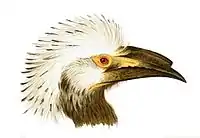White-crested hornbill
The white-crested hornbill (Horizocerus albocristatus), also known as the long-tailed hornbill, is a species of hornbill (family Bucerotidae) found in humid forests of West Africa.
| White-crested hornbill | |
|---|---|
 | |
| T. a. albocristatus at Central Park Zoo, USA | |
| Scientific classification | |
| Domain: | Eukaryota |
| Kingdom: | Animalia |
| Phylum: | Chordata |
| Clade: | Dinosauria |
| Class: | Aves |
| Order: | Bucerotiformes |
| Family: | Bucerotidae |
| Genus: | Horizocerus |
| Species: | H. albocristatus |
| Binomial name | |
| Horizocerus albocristatus (Cassin, 1848) | |
| Synonyms | |
|
Tockus albocristatus | |
Taxonomy
There are three subspecies,[2] which differ primarily in the amount of white to their head and neck and the presence or absence of white tips to the wing-coverts:
Range
The white-crested hornbill has a large range in West Africa, occurring from southern Sierra Leone, east to Benin including Côte d'Ivoire, Ghana, Guinea, Liberia, and Togo. It is frequent in parts of its range. Although its population is difficult to estimate, it is not thought to be threatened.[1]
Gallery
 Head of H. a. macrourus
Head of H. a. macrourus
 At Central Park Zoo, USA
At Central Park Zoo, USA
References
- BirdLife International (2016). "Horizocerus albocristatus". IUCN Red List of Threatened Species. 2016: e.T22725946A94907044. doi:10.2305/IUCN.UK.2016-3.RLTS.T22725946A94907044.en. Retrieved 12 November 2021.
- "Zoological Nomenclature Resource: Bucerotiformes (Version 9.004)". www.zoonomen.net. 2008-07-05.
This article is issued from Wikipedia. The text is licensed under Creative Commons - Attribution - Sharealike. Additional terms may apply for the media files.
